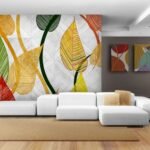Wall treatments can completely transform the look and feel of a room. From textured paints to intricate wallpapers, there are many creative ways to add visual interest to your walls. Upgrading your wall treatments is an affordable way to give your home a quick makeover without a major renovation project.
In this article by Land of Wallpaper, we will explore 6 interesting types of wall treatments and how you can use them in your home. Whether you want to make a statement, add dimension, or just try something new, there is a wall treatment here that will inspire you.
Top 6 Types of Wall Treatments
Textured Paint
Textured or decorative paint is paint that has additives mixed in to create bumps, grooves, or other 3-dimensional effects on your walls. Popular textured paint options include:
- Popcorn ceiling texture: Small bumps scattered across the surface like popcorn kernels. Gives a cottage or rustic look.
- Swirl textures: Create circular indentations for a dynamic, wavy-like pattern.
- Skip trowel: The paint is applied with a special trowel to make peaks and valleys. Adds drama.
An easy DIY project, textured paint brings visual energy to any room. Use it on one accent wall or paint the whole room. It camouflages imperfections beautifully while adding character.
Wallpaper
Wallpaper fell out of favor for a while, it’s back in style again with modern prints and textures. From geometrics to botanicals, today’s wallpapers make a striking statement. Options include:
- Statement prints: Large, graphic florals and modern geometrics demand attention.
- Faux finishes: Wallpapers can replicate finishes like brick, wood grain, concrete, and more.
- Removable: New removable papers make it easy to change up your look whenever you want.
Wallpaper requires more labor to install but makes a decorating splash. Use it to transform a room, highlight an architectural feature, or just over your bed as a headboard alternative.
Wood Paneling
Nothing warms up a room like wood. Real reclaimed barnwood brings organic texture but is pricey. For budget-friendly options, use faux paneling:
- Faux planks: Peel-and-stick wood planks look convincing but are easily removable.
- Board & batten: Vertical boards with thinner strips make a rustic statement.
- 3D planks: Textured planks with hand-carved details take faux to the next level.
Use wood paneling on a whole wall or just a portion. It instantly gives rooms like bedrooms, offices, and libraries a cozier cabin feel.
Brick or Stone
The texture and solidity of brick or stone accent walls add visual weight and dimension. Faux options recreate the look at a fraction of the cost.
- Faux brick: Panels and rollable sheets affordably mimic real reused brick.
- Faux Stone: Lightweight stone sheets have color variations that look authentic.
- Peel-and-stick: Some brick-and-stone products have adhesive backings for super easy application.
Rustic and natural looking, a brick or stone accent wall lends any room an earthy, outdoorsy feel. Use it as the backdrop for a mounted TV or behind a wood-burning stove.
Upholstered Fabric
For a plush, luxurious look, upholstery fabric directly onto your walls. The padding also helps absorb sound. Options include:
- Tufted: Button tufts give a formal, ornate style.
- Modern plain: Sleek, tailored panels create drama.
- Removable panels: Some companies make custom velcro-backed fabric panels that can be changed out.
Fabric walls provide texture and sound-dampening. Use floor-to-ceiling behind the bed for a boudoir effect or on one feature wall in living spaces.
3D Wall Panels
3D wall panels and tiles add customizable dimensions to walls. Materials like MDF, PVC, or foamed plastic come pre-cut into shapes such as:
- Waves and zigzags: Sculptural peaks and valleys create eye-catching shadow effects.
- Geometric tiles: Triangular, hexagonal, or rectangular tiles piece together like a puzzle.
- Floral and leaf shapes: Concentric circles, floral bursts, and leaf silhouettes layer like a trellis.
Modern and edgy or soft and natural, dimensional wall tiles can be painted or stained and are customizable. Use just a few for accents or cover entire walls.
Tips for Choosing the Right Wall Treatments
When considering which wall treatment is best for your room, keep these tips in mind:
Consider the room size. Small rooms can easily get overwhelmed by bold prints or dark colors. Choose lighter colors and small-scale prints for a spacious look. Save the drama for bigger rooms.
- Think about the architectural elements. Work with any special features of the room instead of against them – highlight a fireplace with paneling or soften a window wall with delicate wallpaper.
- Factor in the lighting. The way the light hits the walls makes a difference. Glossy treatments like tile reflect light well in dim rooms while flat or matte paints work better in bright rooms prone to glare.
- Take your time in decision-making. Decorating a whole room or even just one wall is a commitment so choose a long-lasting print or color scheme you still love after living with it for a few days.
- Aim for a cohesive style. The wall treatments should coordinate with your room’s furnishings and style for a pulled-together look. Modern textured paint goes well with clean-lined furniture while reclaimed wood softens sleekness.
- Check wall treatment limitations. White wallpaper and panels have come a long way, some still can’t get wet, delay painting, or limit future changes. Make sure the chosen material works for your plans.
- Follow installation best practices. Prepping surfaces properly makes all the difference in getting great results. Follow all manufacturer directions for long-lasting wall treatments.
- Budget for professionals if needed. While DIY is ideal for many wall upgrades like paint and removable paper, some fixes like removing existing materials or complex builds are better left to experts.
- Pay attention to safety. When dealing with electrical, heavy materials, or working at heights, make safety the priority.
- Think creatively about placements. In addition to covering full walls, small wallpaper or paneling applications can make great focal points over beds, on ceilings, or inside shelves.
With some thoughtful planning and creativity, you can find a wall covering that makes your room shine. The right treatment should capture your style, work with the architecture, and make the room feel complete.
Conclusion
The wall treatments you choose for your home make a significant impact both visually and stylistically. Whether you’re searching for a showstopping focal point, an easy weekend upgrade, or innovative soundproofing, there are 6 interesting types of wall treatments to perk up your walls.
Experiment with wall treatments to refresh rooms without the cost of a full remodel. Use them creatively on just an accent wall or mix and match multiple treatments in one space. Updating your wall finishes is an easy way to add interest, dimension, and sound absorption and completely transform the feel of your home.





